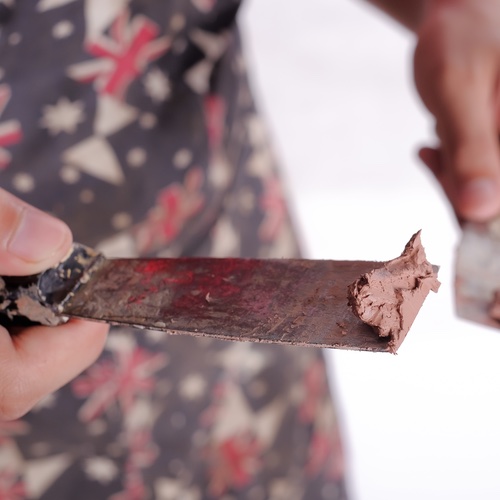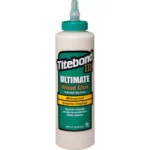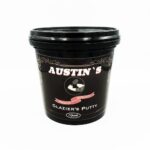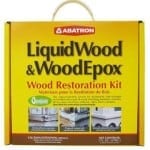
Having worked in the restorations trades for more than 20 years I have constantly been on the search for the best wood filler. I have tried countless products that at first seemed like a winner only to find, just like my high school dating experiences, they wouldn’t go the distance.
The conclusion I have come to is that there isn’t just one product, but rather a group of products that can handle any wood patching task I need. The best wood filler is sometimes not a wood filler at all, but a wood epoxy or even a putty. In this post, I’ll give you my take on the best products to patch wood on the market today.
The first thing you need to consider when choosing the best wood filler is what its use will be. Is it outdoors or indoors, painted or varnished, structural or cosmetic? There is a product for any need listed below, and you’ve just got to find the right one from the list below.
You can also read the results of my 5-year field testing of most of these wood fillers and epoxies at The Wood Filler & Epoxy Test (Year 5) to see how these products performed in the real world as well as to watch the video below.
MH Ready Patch
Best for small cosmetic repairs and surface leveling – MH Ready Patch is a great patch for a myriad of little patches. It doesn’t work for structural patches like an epoxy, but it does work quite well for things like nail holes and surface imperfections in painted wood (it’s not stainable). It dries fast, 30-45 mins and it’s ready to sand.
It is an oil-based product, but it cleans up with soap and water, which I love. I use it to fill holes smaller than a dime in size, smooth out alligatoring paint, surface checks, fill surface gouges or almost anything else I may need. Its only weakness is when you try to fill large areas which causes it to sag and shrink. Keep it limited to very small areas and always make sure you paint it because it will not last if left exposed to the elements.
LiquidWood & WoodEpox
Best for structural repairs or rebuilding of big portions of wood – There are tons of different types of epoxies for wood, but this product is by far my favorite because of its ease of use and long performance.
We use this every single day and my rot repair franchise Preservan uses a similar product by the truckload. The two parts work together to stabilize “punky” wood and fill in the missing areas.
The repairs can be sanded, drilled, planed, and essentially you are left with a repair that performs just like wood but will never rot or fall out. Epoxy repairs are some of the strongest, most long-lasting ways to patch wood. They are structural, so they can be used anywhere and are usually not troubled by water issues like other wood fillers.
Got some serious rot? This is the stuff you need. For info on how to use this awesome product, read my tutorial How To Repair Rotted Wood With Abatron Epoxy.
KwikWood
Best for small structural repairs in a hurry – Anyone who occasionally needs to patch wood should have a tube of this sitting in their shop or garage. This is a very simple to use 2-part epoxy that you mix with your hands. It’s kind of like squishing a tootsie roll together to mix both parts. Once you mix it, you have about 10 minutes before it starts to set up, and in 20-30 mins it is hard as a rock.
I use it to fill screw holes that have stripped out so I can get a sagging door hung again quickly or other tasks like that. Its fast drying time and resistance to rot and mildew make it perfect for exterior repairs too. I have used it outdoors and left it unpainted for years (not on purpose) with no problem.
Minwax Wood Filler
Best all-purpose wood filler – You knew I’d get around to an actual wood filler soon, right? Minwax Wood filler is such an easy to use and great product I am constantly surprised by how good it does for how little it costs. In the video above you can see the incredible results I got after a 5 year test with this stuff. It outperformed some epoxies and more expensive products big time.
It’s simple to apply with a finger tip or putty knife, sand when it’s smooth and prime when you’re done. No mixing to screw up. The fact that it’s not structural just means it should not be used for larger applications like the Abatron products above. It’s also a great option for stained and varnished projects as well as paint grade repairs.
Sawdust & Wood Glue

Best for color matching and flooring joints – This is a weird little trick that an old floor refinisher taught me and it really has worked great in very specific circumstances. Here’s how it works:
To patch wood using this method, you’ll need sawdust from the specific wood you are patching. Mix it with enough wood glue to get the consistency you need. You can make this a wet slurry and trowel it into the joints between old floor boards or make a thick paste to fill spots on damaged furniture.
You have to work fast enough that the glue doesn’t begin to dry on you, but to match the color of a repair for something that will be stained and varnished there is nothing better. Once it’s dry, sand the surface thoroughly and you’re good to go.
Austin’s Glazier’s Putty

Best for flexible joint filling – Glazing putty isn’t a wood filler, right? Wrong. For filling nail holes or joints glazing putty is actually incredibly useful.
Some glazing putties are bright white (DAP 33) which can hide well for painted trim, but are hard to see if you’ve gotten good coverage plus they can take weeks to cure. That’s why I created my own glazing putty with the help of the folks at Sarco Putty Co. that is usually ready for painting within just 24 hrs. It is also available in a brown color to blend in better for varnished projects.
For a better option to filling joints and ease of application you can’t beat a glazing putty. I can often use this in place of caulk for certain circumstances where more body is required than caulk which tends to sag.
What to Avoid
You’ll notice that there is one product I specifically did not include here that a lot of people use…Bondo. There is a good reason why it is not included in a post about the best wood filler and I’ve outlined why you should absolutely avoid Bondo when it comes to patching wood in this more in-depth post.
I’d love to hear what your experience has been with these products and if you have other favorites that you’ve found over the years. Are these truly the best products to patch wood or is there some other product that deserves the title of best wood filler.

Founder & Editor-in-Chief
I love old houses, working with my hands, and teaching others the excitment of doing it yourself! Everything is teachable if you only give it the chance.






Got cracks? I found that taking tooth picks, flat or round, your choice, moistening them with alcohol and shaping them to the crack, putting in wood glue and putting in the picks with a screwdriver or pointing tool will work great, dry and sand.
Hello Scott, I wonder if you have a recommendation for a wood filler that could fill gaps in a pre-finished wood floor. I have some gaps throughout the floor between the floor boards and I’m looking for filler that will not shrink, create a durable bond and flowable enough to apply into the gaps (roughly 1/8″). Thanks for your help!
– Ken
I have a couple nicks in my wood pub table. They are down in to the unstained wood part but less than the size of a pencil eraser. What is the best product to fill them with. I am affraid if I have to sand these two small spots it will be a total refinish process and I don’t want that. TIA
Susan, most fillers will need sanding to blend in perfectly. You may try using a stain pen to hide the nicks rather than filling staining and finishing the small area.
Hello Scott, What filler or caulk would you suggest for the exterior of my house? We helped paint any other house and the area where the filled and caulked was showed a different color from the wood area. We also used a primer and paint. Thank you
Hi. I have an antique spinning wheel that was well used. I plan on using it again, but the treadle where it is joined to the wheel with a rod is almost worn through. There is about 1/8″ of wood left, and it’s about an1/2″ square hole, open on 3 sides. I will need to drilla hole in this patch and it will need to hold up to significant stress. I also did not want to paint it, but keep the original finish. Is an epoxy filler my best bet?
Of all the fillers epoxy would be best but in this case a Dutchman repair would probably give you the strongest solution.
Scott thanks for your great info!
We have a mahogany deck with some snow/water damage around some screws. Want to repair, fill, and stain. Looks like WoodEpox is your go to? What about MinWax stainable wood filler? Thanks
For an exterior deck I would stick with the epoxy. Wood filler doesn’t hold up quite as well.
I am replacing carpet. I needed to chisel out some rotted floorboard. (I reduced the 3/4″ thick floor board to 1/2″ thick place in a small area up against the wall). Now the carpet installer cannot lay the tack strip down because a portion of the floorboard is gone. What would you recommend I use to fill in the flooring? It needs to be strong enough to support the tack strip and the carpet stretching process?
I would try some standard wood filler.
Thanks for answering all of these questions! I have another if you have time.
I am repainting our colonnade which was unfortunately made with several pieces of rough knotty pine. What should I use to fill in the rough spots around the knots? I have already applied a few coats of clear shellac to the knots- have not primed yet.
Thanks for any suggestions!
Carmen
I use WoodEpox for knots holes all the time. Works great!
We built a farm house style table but have found the cracks between the boards on the tabletop catch too many crumbs. My idea was to fill it with Elmer’s Wood Filler, sand it, then stain and polyurethane the top again. My only concern is that where we did this same thing on the screw holes in the frame, there are now raised spots, like the filler expanded out. What would be the best method to fill these cracks? Did we do something wrong on the screw holes?
Emily, the filler is likely being pushed out from wood movement. Try an epoxy like WoodEpox or Minwax Hohh Performance Wood Filler to fill the gaps.
I am making a table out of a circular cut of a tree trunk. In the middle there is a hole about 1″ deep and 2″ wide and I want to fill it with something CLEAR. What would you suggest? Epoxy?
Yeah, a clear epoxy would be my choice.
Hi. We bought a long wood table at a flea market made out of barn siding. It had been sanded and refinished. However there is a crack going down one side of the table. It has not reached the other end, but I’m sure it will. It is getting wider as well. What is the best filler to use since the table has already been stained and varnished?
Thanks for your help.
Lisa
Scott, this article and posts/discussion are great. We had plywood subfloors (interior) that we painted 10 years ago; they held up great but were recently damaged by a burst frozen pipe. What product would you recommend for filling counter-sunk nail holes & especially seams for our new plywood floors to be painted? We plan to faux finish using latex paint & use Endurovar water-based varnish to seal. Thanks for your help! Kim
Hi – I paint furniture and resell it. I recently got a desk that had several predrilled holes about an inch in from the side space about 3/4″ apart (maybe for a piece of decorative trim that is long gone). I filled the holes with spackle, sanded and painted. You can still see small rises where the spackle was. How can I fix this without sanding off the entire desk top? Thanks
Susan try using an epoxy filler like WoodEpox to fill the holes instead of spackle. Overfill with the epoxy then sand smooth and level and it will last a long long time.
Hi Scott,
I purchased hardwood yellow pine (butcher block style) random length and widths planking. I was told these planks are used to mfg laminated structural beams. I ripped them down to the same widths and made a floor out of them, looks really old, warm and unique. Now 10 years later I have gaps 1/8 to almost 1/2 inch between some of the boards, summer time they do minimize some. I am not feeling up to ripping the floor up and tightening the gaps. I was looking for a spreadable acrylic glossy type liquid to just pour over the entire floor.. we have some splinters as well.
What do you think
The epoxy options sound like something to try. I’ve used Durham’s and have been pleased. I’ll have to try a thicker consistency to see if I can mold it like clay. I’ve never been a fan of wood filler though. It doesn’t seem to stick, so when I try to spread it out with a putty knife it just rolls up and falls out. If Elmer’s makes it shouldn’t it have a glue-like consistency?
High end frames have seamless joints –what kind of wood filler do they use? I’m framing a vanity mirror and want to make the joints seamless.
Gloria, an epoxy or since its interior only you could also use Bondo to fill the joints for a seamless appearance.
We rewired our 100 yr. old apartment and our painted bsseboards were left with holes where the old outlets were housed. What is the best way to fill these holes? Can we use an epoxy or do we have to use blocks of wood?
Nikki, I would use blocks of wood to patch these otherwise known as a Dutchman repair.
I am trying to figure out the best way to get a smooth exterior patio ceiling. Installers put in CDX and what I believe is bondo to fill in the seams. After 2 yrs, the seams along the longer boards are separating. Looks like the bondo has failed. What is the best thing to use in this case? An epoxy wood filler? I want to be able to get as smooth as a finish as possible that will last.
Robin, an epoxy filler like WoodEpox will work better in this case because it will flex with the wood in seasonal changes.
I have an old door and am having difficulty screwing in the deadlatch to the door because of decayed wood.
Do you have any advice about how to get the screws to stay?
Thanks
Eric – Depending on the door and state of decay; my goto would be to line the precious holes with a generous helping of glue and then use dowels, cut strips of shims, or even just inch long by 1/4″ scraps/cut-offs, gently tapping them into the holes and leaving it to set before coming back and trimming them off with a chisel before pre-drilling new holes. If the state of decay is fairly bad you may want to remove some of the interior section with a chisel and cut a few new blocks to fit inside the door, paving the way for them with again a generous helping of glue a possibly a couple clamps across the thickness of the door even if the blocks are accurately snug-fit. If the decay is not very bad at all you could always just stick a match stick in the hole (or something similar) and try the screws again, giving the screws something to bite into. Hope this helps. 😉
I’m trying to repair a staircase railing where they used something non-stainable to plug the screw holes. What’s the best way to remedy this? Can I dig out the old and replace with a new, stainable product? If so, would you recommend the MH Ready patch for this, or could I get away with the Elmer’s Wood Filler?
Melissa, you got it. Dig out the old patch and filler with a new stainable wood filler. You may even find a pre-mixed wood filler that matches the color you need. Stay away from MH Ready patch in this case since it isn’t stainable.
Hey,
So I have a mantelpiece that had a candle go awry and charred a square about 3/4 inches deep and 3X3 inches in a square (if you can visualize that). I have removed most of the charred wood and am wondering what would be the best route to report this, also the most cost effective of course.
Tyanna, I would use standard wood filler or Durham’s Water Putty for this repair. Overfill the area and sand it level once it’s dry. Then prime and paint.